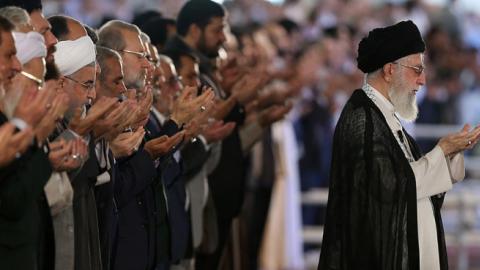Why does Iran continue to saber-rattle and threaten to massacre Israelis? Why do Iranian religious and military leaders constantly vow to impose terrible violence on their enemies? And why is the ever-escalating aggression carried on by various Iranian proxies across the Middle East?
These days, international commentators assume that threats of violence and warnings of war are Iran’s boastful way of defying US economic sanctions, which presently have a strangle-hold on their leaders and institutions. Meanwhile, disturbances in the Persian Gulf have underscored the Islamic Republic’s rage at America’s withdrawal from the JCPOA.
But there is, perhaps, another reason as well – an apocalyptic belief that is widely held by Iran’s supreme leader and his followers.
On August 6, the indispensable MEMRI news site – which translates and broadcasts speeches, sermons or other pronouncements by sheikhs, imams and mullahs – reported the words of senior Iranian Ayatollah Mohammad Mehdi Mirbagheri: “In Order for the Hidden Imam to Reappear We Must Engage in Widespread Fighting with the West.”
More about the Hidden Imam in a moment.
Meanwhile, in recent weeks, the regime has threatened to cut off international routes for petroleum shipments. Oil tankers have been attacked, seized or threatened. And there has been a nearly constant stream of doomsday warnings – “Death to America” and “Death to Israel.”
In mid-July, Lebanon’s Hezbollah leader, Sayyed Nasrallah, declared that while “life and death are in the hands of God, logic points to me praying in Al-Aqsa mosque.” Bear in mind that while serving as Iran’s front-man in Lebanon, Nasrallah has been living in a secret underground location ever since the 2006 Israel-Lebanon War.
Al-Aqsa Mosque is, of course, located on the Temple Mount in Jerusalem. So Nasrallah’s prediction essentially means that at some point, Israel will no longer be able to prevent his coming out of hiding to enter the Holy City.
Then, just days after that declaration, Iran’s Supreme Leader Khamenei affirmed Nasrallah’s prediction: “The return of this holy land [Israel] to the World of Islam is not a strange and unattainable matter.” He declared Nasrallah’s goal of praying at the Al-Aqsa Mosque “an absolutely practical and achievable aspiration for us.”
Some observers are aware of the deeply religious nature of Iran’s regime. However, in the US and Western Europe particularly, references to religious influences in international affairs are either disregarded or find their way into an editor’s trash can.
But in fact, some declarations should not be overlooked. And that includes references – particularly among Iran’s highest levels of leadership – to the Hidden Imam.
The Hidden – or Twelfth – Imam plays a dominant role in one specific form of Shi’ite Islamic theology, called “Twelverism,” which happens to be the primary belief system of Iran’s leadership. There is a messianic belief that at the end of days, the Hidden Imam will appear in the midst of a violent apocalyptic scenario played out on a battleground stained with infidels’ blood.
My first awareness of this Shi’ite theological issue came from a 2009 book, The Rise of Nuclear Iran, written by Ambassador Dore Gold, who serves as an advisor to Israel’s Prime Minister Benyamin Netanyahu.
More recently, as I reflected on the intensifying tension between the West, Israel and Iran, I came across a blog post from an Iranian scholar who is now serving as a fellow at Washington DC’s highly respected Foundation for Defense of Democracies (FDD). In 2013, Saeed Ghasseminejad penned an article titled “Iran’s Apocalyptic Policy Makers.” He wrote:
“Two of the most lunatic and apocalyptic high-ranking figures in Iran are Ayatollah Ali Khamenei himself and his now disgraced one-time protégé, Mahmoud Ahmadinejad. While Khamenei deeply believes his task is to prepare for Mahdi’s appearance, Ahmadinejad takes the apocalyptic narrative to an unprecedented level of lunacy and weirdness, even by the Islamic republic’s measures. He believes, for example, that the real reason behind the US invasion of Iraq was to search for the Hidden Imam and to postpone his appearance. Many observers believe Khamenei chose Ahmadinejad as president mainly because of their shared belief in this apocalyptic version of Islam.
“While many experts tell us Iran is a rational, pragmatic regime like any other in the world, all the facts shout that it is not. A large number of Iranian officials and decision makers have deeply rooted apocalyptic beliefs. Underestimating this radical ideology even as the Iranian regime is on its way to building a nuclear bomb can lead to dangerously wrong conclusions. The suggestion taking hold of late that a nuclear armed Iran is not the end of the world may unfortunately be dead wrong.”
With this in mind, I interviewed Saeed Ghasseminejad and asked what he thinks about Iranian aggressions today.
“I think policymakers in the West should take the IRI official’s apocalyptic vision seriously,” he told me, “because that is what drives Tehran’s decision-making process. Preparing the ground for the reappearance of the Hidden Imam is the Islamic Republic’s raison d’etre. Ignoring it leads to misinterpretation of Tehran’s actions and miscalculation by Western policymakers.”
Short version: When assessing the next scenario vis-à-vis Iran’s aggression and seemingly relentless push toward conflict, don’t overlook their apocalyptic theology. It’s more significant than most of us imagine.



















